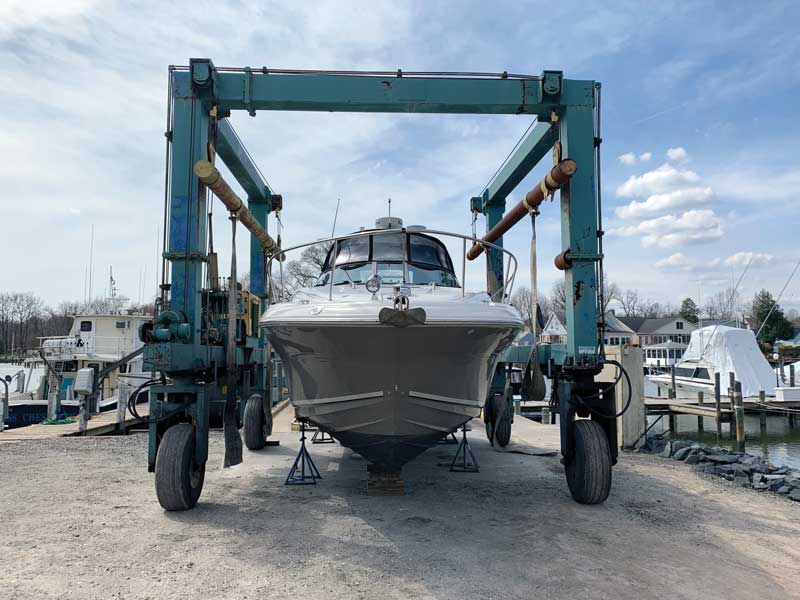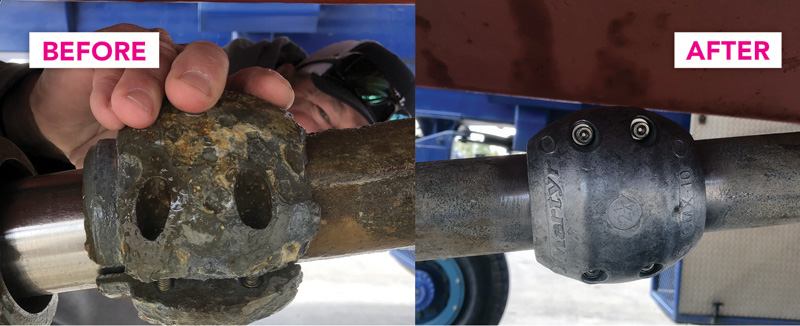Getting your powerboat ready for spring commissioning and the summer season is always about details. If your boat is in the care of a good boatyard or marina, the personnel commissioning the engine for the season will, if possible and generally for smaller vessels and outboards, hook up an external water supply and run the engine so that you can be sure that, when she splashes, the engine will start quickly and without any trouble. This is also a good time (for the owner and the mechanic) to make certain that the raw water system is clear of sea growth, barnacles, or any other obstructions. After all, it’s a lot easier to clear and clean completely while your boat is still up on the hard.

Thinking that I might put together a short checklist of things that boaters tend to forget, but that should not be forgotten ever, I reached out to Vaughan Scott at Diversified Marine Services in Annapolis. She replied with a short but excellent list of things that are frequently overlooked, and at the top of the list was attention to the raw water system. I’ve had my own experiences with dysfunctional raw water rigs; I owned a boat once with a somewhat antiquated Jabsco pump that frequently became air-bound. Once it did, within moments, the hard rubber pump impellers broke off inside the pump, the flow of water stopped, the engine overheated, and that was the end of the trip at least for that day.
Vaughan advises one to review the raw water system from the thru-hull intake to the strainer, through the engine, and proper discharge from the exhaust, and to check the sea strainer lid(s) to make sure that they are tight and not leaking; confirm that all lids were removed when winterizing. In the spring, she says, “we find a fair amount leaking or pulling air into the system.” That’s one quick way to get a raw water pump air-bound and invite failure.
It also goes, without saying, that if you’re cleaning out the thru-hulls, exercise the seacocks, lubricate and open and close all the way several times until you are satisfied that there is no undue friction or resistance, and disassemble and grease any that do seem sticky.
Also, Vaughan advises:
- Verify all engine fluid levels, coolant, oil, and gear oil.
- Verify fuel flow and quality.
- Lubricate shaft seals (or repack the stuffing box).
- Check hose and clamp conditions.
Perhaps the most important thing to remember is that it’s not what you remembered to do that’s important, it’s what you forgot to do that matters.
After a few years of owning a boat, or rather the same boat, the fall and spring preparation routines become just that, i.e., routine, almost automatic, but it’s the small things that can be overlooked. I can get my water system online and un-pickled, test my electronics, and perform a thorough cleanup belowdecks, but in the springtime, more effort and attention are focused on my boat’s bottom than anywhere else. I’m going to check and replace zincs or anodes, pay special attention to my propeller and the condition of my cutless bearing, and clean and inspect my electrical grounding plate. My boat’s lightning protection system grounds to that plate, so it is critical that its conductivity is good.

Unless my propeller whacked a mooring ball, chain, piece of wood, or other solid object the previous season, I have no reason to suspect damage, but if it has, I inspect it carefully, looking for dings, pitting, cracks, and distortion. Damaged propellers can cause unwanted vibration and wear, particularly to the cutless bearing and shaft log, possibly resulting in leakage. When in doubt, remove the prop, even the prop shaft, if need be, and take them to a prop shop to be straightened and propeller pitch re-set.
I always inspect any and all fire extinguishers aboard for loss of charge, and also for the expiration date. That’s one of the first things officials look at during a boarding and inspection.
Check safety equipment, especially life jackets or PFDs, check for mildew, rot, and other conditions that may have developed over the winter and could compromise the strength and integrity of the material. Make sure that you have enough on board for every potential passenger, and that they are the correct size.
Springtime is a great time to thoroughly wash the hull and perform a careful inspection for blisters, distortions, and cracks, especially before painting on antifouling.
Make sure that the drain plug is securely in place before launch. It’s amazing the number of boaters who forget this simple detail, with predictable results!
For any enclosed or semi-enclosed engine area, ensure that you have at least one properly installed and working carbon monoxide detector.
Electrical System
Inspect all electrical connections to ensure clean, tight, corrosion-free connections. Remove corroded terminals and use a wire brush to clean them, along with all cable ends. Charge the house and starting batteries and have them tested to ensure that they can hold a charge.
Oil and Coolant Levels
Check all fluid levels including engine oil, power steering, and coolant. Be sure to change the engine oil, oil filter, and drive lubricants. Inspect the fuel system for leaks or damage and be sure to pay special attention to fuel hoses, connections, and tank surfaces. Evidence of a damaged fuel hose includes softness, brittleness, or cracking. Replace components when necessary and verify that all fittings and clamps are properly secured. Never re-use hose clamps; they are treacherous.
Belts and Cables
Check drive belts because they can become brittle and may crack during winter storage. Belts should fit tightly around pulleys to prevent slipping. Black powdery residue near the pulley, and a looseness in the belt may indicate a worn belt that is prone to failure. I always keep aboard two spare belts of whatever type or sizes that the engine(s) need.
Cracks or swells on the outer jacket of the throttle, shift, and steering control cables may be indicative of internal corrosion, resulting in eventual failure, so replace them.
Hydraulic Fluids
If you’re a wooden boat type of person, as I have been for most of the years that I have owned and operated boats, then buying a new wooden boat—new to you, I mean—is like becoming re-acquainted with an old friend whom you have not seen for a very long time, or someone who seems familiar in many ways, even though you know that you haven’t met before. There will always be surprises, subtle differences, and odd and curious old pieces of hardware, some original, some old and added later. When I began crawling through the bilges of my 1929 cruiser Anna Mary a year ago, I discovered that she had been outfitted with a hydraulic steering system, basically a piston, hoses, and a wheel, not 1929 vintage by any means, but simple enough to be respectable, with nipple connections so that it could be easily purged and charged with a reddish fluid that looked a lot like ATF but was not ATF. I ordered a quart of the pricey, proprietary stuff and, following the simple instructions, charged and topped off the system, and successfully actuated the rudder.
In contrast, I had the opportunity to help deliver an aging cabin cruiser a few years back from the Chesapeake to Mobile Bay. It’s obviously a long trip, and I was excited by the prospect of making the voyage with my captain friend and the new owner and his wife. The new owner of the big 65-foot cruiser was spending a lot of money preparing the boat, putting in new battery banks, and making many other upgrades, but the boat had been sitting in a muddy creek with the previous owner living aboard her for 15 years.
The boat never went anywhere, and when I looked into the wheelhouse, I was startled to find myself looking at what seemed to be a time machine, unaltered since it had been new. We found that many things didn’t work or work right, but we could live with them, mostly. What killed the trip happened when the yard mechanics went to top off the hydraulic fluid reservoirs. They didn’t do their homework and didn’t realize that the type of fluid used by this Ark was alcohol-based, like brake fluid, instead of oil based, and they topped off the reservoirs with ATF fluid. The result? Something resembling orange mayonnaise when they tried to start her up. The trip ended before it began, with the boat towed, hauled, and eventually sold at a loss. So, remember that assumptions can be dangerous; always make sure that you are using the right fluids that the boat’s systems require, particularly and especially if the boat is “new” to you.
Have a great season on the water!
By Captain Michael L. Martel